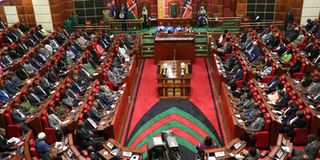Uneasy calm marks key speech

A joint National Assembly and Senate sitting at Parliament Buildings in Nairobi on March 27, 2014. In an attempt to entrench equivalence, the law we passed in 2010 gave us a Senate whose one year of existence has been characterised by a serious identity crisis. PHOTO | BILLY MUTAI |
What you need to know:
- From the public gallery, the Cabinet secretaries looked down at the chamber where barely 24 hours before, MPs denied them the power to fly the national flag on their vehicles
- The diplomatic boxes on either side of the chamber were full but the public galleries were half empty, so strict was the security that even most reporters stayed away from the press gallery
President Kenyatta was 35 minutes into his State of the Nation address on Thursday afternoon when he paused.
He had just talked about his decision three weeks ago to take a 20 per cent cut in his pay when an MP seated in the opposition benches on his left clicked his tongue loudly.
Some MPs on the same side had been shaking their heads from the time the President started his address with the words, “The Jubilee administration…” and after the click, others dismissed the Head of State’s statement with a wave of the hand.
The Jubilee side laughed as President Kenyatta stopped reading from the sheaf of orange papers in his hand and when the moment passed, he continued.
LOUD SUGGESTION
That pause marked the loudest suggestion of disappointment in the 47 minutes the President spent making his State of the Nation address to the two Houses of Parliament.
Unlike other days, the chamber began filling as early as 2pm, 25 minutes before the time President Kenyatta was scheduled to arrive at Parliament Buildings, Nairobi.
The idea was to get the best seats and avoid the chairs crammed in the aisles to accommodate the senators and members of the National Assembly, who also had the rare opportunity to sit together.
The modern chamber can only sit 350, but Parliament has a combined 416 plus the two Speakers and they had to make do with sitting close together despite their political animosity.
There were still about 10 empty seats in the House at the end, though, with the seats nearest the doors being avoided.
From the public gallery, the Cabinet secretaries looked down at the chamber where barely 24 hours before, MPs denied them the power to fly the national flag on their vehicles.
Below them, in the Speaker’s gallery, was the head of the National Intelligence Service, Major-General Michael Gichangi, deputy Chief Justice Kalpana Rawal, Nairobi Governor Evans Kidero and Chief of Defence Forces General Julius Karangi, with all the service commanders on his left.
Between Dr Kidero and Gen Karangi, on a seat more colourful than theirs with a higher back, was Deputy President William Ruto.
He sat directly opposite the man he likes to call “my brother” who sat in the Speaker’s seat shortly after walking in a few minutes to 3pm.
The diplomatic boxes on either side of the chamber were full but the public galleries were half empty, so strict was the security that even most reporters stayed away from the press gallery.
Under the Constitution, Parliament controls its own calendar, meaning the traditional opening of the House, where the full power of the presidency was often on display, was erased.
But it is hard to get rid of old habits and the presidential address was marked with all the fanfare of the old opening of the House, which usually happened at the beginning of March.
It meant the President had to inspect a guard of honour mounted by a detachment from the Kenya Air Force and sign the visitors’ book.





